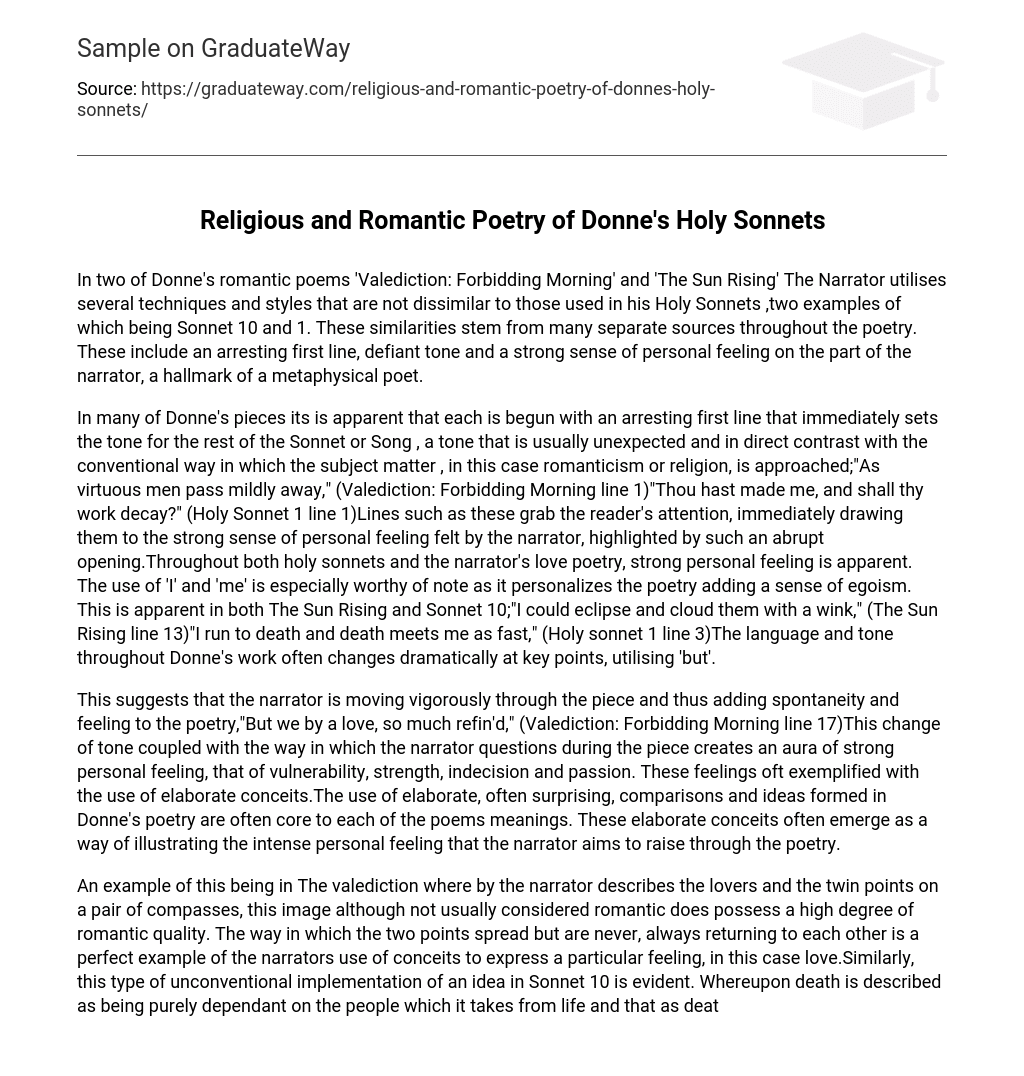In two of Donne’s romantic poems, namely “Valediction: Forbidding Morning” and “The Sun Rising,” the narrator employs various techniques and styles that are similar to those found in his Holy Sonnets, particularly Sonnet 10 and Sonnet 1. These similarities can be traced back to different sources within the poetry, such as a captivating opening line, a rebellious tone, and the narrator’s intense personal emotions, characteristics that are typical of a metaphysical poet.
Donne’s works often begin with a striking opening line that sets the tone for the rest of the Sonnet or Song. This tone is usually unexpected and in contrast with how romanticism or religion is typically approached. For example, lines like “As virtuous men pass mildly away” (Valediction: Forbidding Morning line 1) and “Thou hast made me, and shall thy work decay?” (Holy Sonnet 1 line 1) immediately capture the reader’s attention and convey a strong sense of personal feeling. The use of “I” and “me” throughout both holy sonnets and love poetry adds a sense of egoism. This can be seen in lines such as “I could eclipse and cloud them with a wink” (The Sun Rising line 13) and “I run to death and death meets me as fast” (Holy sonnet 1 line 3). Donne’s language and tone often undergoes dramatic changes, often using the word “but” at key points.
The narrator’s vigorous movement throughout the piece adds spontaneity and emotion to the poetry, as seen in the line “But we by a love, so much refin’d” (Valediction: Forbidding Morning line 17). The change in tone and the narrator’s questioning create a strong sense of personal feelings such as vulnerability, strength, indecision, and passion. These feelings are often exemplified through the use of elaborate conceits. Donne’s poetry relies heavily on these elaborate and unexpected comparisons and ideas, which are essential in conveying the intense personal emotions that the narrator seeks to evoke.
In “The Valediction,” the narrator uses the image of twin points on a pair of compasses to describe the lovers. This image, although not typically considered romantic, possesses a significant amount of romantic quality. The way in which the two points spread apart but always return to each other serves as an example of the narrator’s use of conceits to express love. A similar unconventional implementation of an idea is seen in Sonnet 10. In this sonnet, death is described as dependent on the people it takes from life. The poet suggests that death is merely a quick sleep, after which eternal happiness is possible. Therefore, we become immortal at this point and death itself becomes dead, not the souls of those who have died and whose souls “wake eternally.”
Donne’s holy sonnets and love poems rely heavily on the creation and application of unconventional ideas. Despite this, Donne adheres to a strict rhyme structure and technique in his poetry. This contrast between the unconventional ideas and technical disciplines keeps the reader engaged, showcasing the narrator’s respect and Donne’s respect for the poetry itself. Examples include lines from “The Sun Rising” and “Holy Sonnet 1.” These poems follow a fourteen-line scheme with a ten-line per verse scheme, using iambic pentameter and petrarchan structure to showcase Donne’s technical expertise. The attention to detail in these technical aspects adds tension to the poems, emphasizing the informality, passion, and unorthodox methods found throughout the text.
Donne’s poetry stands out in its defiance of conventional poetic methods during his time. The narrator in Donne’s poems often challenges seemingly untouchable powers, such as scolding the sun for entering his room without permission in the morning, mocking death for its lack of real power, and questioning and pressing God in a way that assumes equality. These informal and egoistic points sharply contrast with the respect Donne shows towards these powers, particularly during the Elizabethan and Jacobean periods when he was writing.
Donne desires to challenge powers, near equality, which emanates a sense of instability. He yearns for more power to enact both physically and spiritually, evident in his Love poetry and holy sonnets. This instability stems from a salvation anxiety experienced by Donne throughout his work. By daring to question the controlling powers, particularly religious ones, he grants himself the courage to ask introspective questions about himself and his circumstances that he would otherwise lack the bravery to do.
Donne’s technique in his love poetry is to elevate his own will to match that of the object of his affection. This allows him to express more intense emotions without feeling constrained by tact or respect for the power he addresses. This approach also leads to unconventional ideas and comparisons in his poetry, as the narrator feels empowered to relate them to the reader. For example, in sonnet 1, the line “Thou hast made me, And shall thy work decay?” demonstrates how Donne’s tone takes on a commanding and questioning nature towards God. This practice of asserting authority in the beginning of the sonnet prevents the narrator from becoming submissive and maintains the intensity of the poem. Overall, it is evident that there are many similarities between Donne’s love poetry and holy sonnets, which can be attributed to the heightened emotions expressed in all of his works.
Whether expressing his emotions to a lover or to God, Donne’s sentiments revolve around his anxieties. However, he covers them up with a captivating confidence throughout. The similarity between Donne’s holy sonnets and love poetry is noticeable. In both cases, the narrators employ innovative and unconstrained thinking through elaborate metaphors that lead to a strong sense of personal emotions bound within a rigid and structured tension. This likeness in mind and soul makes John Donne notably similar.





